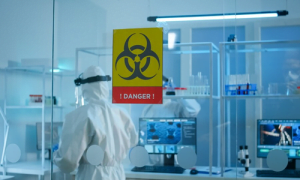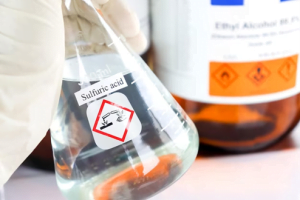USECHH Regulation 2000.The workplace is an environment filled with various substances, and among them, some can pose significant risks to human health.
This is where rules like the USECHH Regulation 2000 come in, ensuring that hazardous chemicals are handled safely in the workplace.
What Is USECHH Regulation 2000?
The USECHH Regulation 2000, stands for Use and Standard of Exposure Chemical Hazardous to Health Regulations 2000.
It is a crucial framework designed to prevent and control major accidents involving hazardous chemicals.
This regulation applies to industries dealing with such substances to ensure the safety and well-being of workers.
Key Objectives of USECHH Regulation 2000
Crafted to empower employers in managing chemicals hazardous to health, these regulations establish guidelines to safeguard the well-being of employees and others present at the workplace.
Let’s delve into the specifics of these regulations, highlighting the key duties imposed on employers.
1. Identifying Chemicals Hazardous to Health

The cornerstone of USECHH Regulations is the identification of chemicals posing a risk to health.
Employers are mandated to discern and categorize such substances within the workplace, laying the foundation for subsequent safety measures.
2. Complying with Permissible Exposure Limits
To ensure the health and safety of employees, employers must adhere to permissible exposure limits (PELs).
These limits define the maximum concentration of hazardous chemicals permissible in the workplace, preventing excessive exposure.
3. Carrying Out Chemical Health Risk Assessment
A critical aspect of USECHH Regulation 2000 is the performance of chemical health risk assessments.
This process involves evaluating potential risks associated with hazardous chemicals, guiding employers in implementing effective control measures.
4. Taking Action to Control Hazardous Exposure

Upon identifying risks, employers are duty-bound to take proactive measures to control hazardous exposure.
This may involve implementing engineering controls, administrative measures, or providing personal protective equipment (PPE) to minimize the impact on employee health.
5. Labeling and Relabelling Chemicals Hazardous to Health

Clear communication is key in ensuring workplace safety.
Employers are required to label and, if necessary, relabel hazardous chemicals, providing essential information about potential risks and safe handling procedures.
6. Providing Information, Instruction, and Training
Empowering employees with knowledge is integral to a safe work environment.
Employers must furnish comprehensive information, instruction, and training regarding the risks associated with hazardous chemicals, along with the necessary precautions.
7. Monitoring Employee Exposure at the Place of Work
Continuous monitoring is a proactive approach to maintaining a safe workplace.
Employers should regularly assess and monitor employee exposure to hazardous chemicals, ensuring that levels remain within permissible limits.
8. Conducting Health Surveillance
Caring for the well-being of employees goes beyond prevention.
Employers are obligated to conduct health surveillance, keeping a vigilant eye on the health status of individuals exposed to hazardous chemicals.
9. Posting of Warning Signs
Visual cues are essential in areas where hazardous chemicals are present.
Employers must prominently display warning signs, alerting individuals to potential risks and fostering a heightened sense of awareness.
10. Record Keeping
In the spirit of transparency and compliance, employers are required to maintain meticulous records.
This includes documentation of chemical identifications, exposure assessments, and any actions taken to control hazardous exposure.
Benefits of Adhering to USECHH Regulation 2000
Adhering to the USECHH Regulation 2000 offers a host of compelling benefits, creating a safer and more efficient work environment.
1. Enhanced Workplace Safety

By aligning with the USECHH Regulation, your businesses prioritize the safety of your workforce.
This proactive approach significantly reduces the likelihood of accidents and incidents related to hazardous chemicals.
A secure work environment fosters employee well-being, morale, and a positive workplace culture.
2. Mitigation of Risks
Compliance with USECHH Regulation entails a thorough risk assessment and management process.
Identifying potential hazards and implementing effective control measures significantly reduces risks associated with the handling of hazardous chemicals.
This, in turn, safeguards both employees and the environment.
3. Improved Overall Productivity

A safe and compliant workplace is inherently more efficient.
Employees can focus on their tasks without the constant concern of potential hazards, leading to increased productivity.
Moreover, adherence to regulation streamlines operations, ensuring a smooth workflow that is not disrupted by preventable accidents or emergencies.
In summary, USECHH Regulation 2000 serves as a cornerstone in ensuring the safe handling of hazardous chemicals in the workplace.
Adhering to its guidelines not only protects individuals and the environment but also contributes to the overall success and sustainability of industries.
Get your employees health and welfare protected by get them checked by OHPlus today.
Sign up today and experience improved compliance, resilience and productivity.
OHPlus will provide instant access to a large pool of highly qualified occupational health professionals, and our adaptable approach ensures that your business specific needs are met.
Under OHPlus, you can subscribe to:
- Audiometric Screening
- Audiometric Diagnostic
- OHD Examination
- ENT/Audiologist Services
- Fitness To Work
- Return To Work
- Medical Surveillance
- OH Consultation

